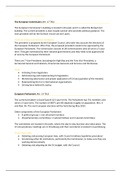Lecture 1 | The EU institutions
The European Commission (Art. 17 TEU)
The European Commission’s building is located in Brussels and it is called the Berlaymont
building. The current president is Jean-Claude Juncker who provides political guidance. The
next president will be the German Ursula von der Leyen.
Terms & voting: Commission members
The president is proposed by the European Council, who take into account the elections of
the European Parliament. After that, the proposed president needs to be approved by the
European Parliament. The Commission consists of 28 Commissioners who all serve a 5-year
term. They get nominated by their national governments and they need to be approved all
at once by the European Parliament.
There are 7 Vice-Presidents (including the High Rep and the First Vice-President), a
Secretariat General and Cabinets, Directorate-Generals and Services and the Bureau.
Tasks
• Initiating Union legislation.
• Administering and implementing EU legislation.
• Monitoring observance and proper application of EU law (guardian of the treaties).
• Representing the EU in international organizations.
• Driving force behind EU policy
European Parliament (Art. 14 TEU)
The current president is David Sassoli (2,5-year term). The Parliament has 751 members and
serve a 5-year term. The number of MEP’s per MS depends roughly on population. Min. 6
and Max. 96. The next European elections will be held during May 2024.
Other components of the European Parliament:
• 8 political groups + non-attached members
• 20 parliamentary committees: 2 subcommittees and 3 special committees
The committees are located in Brussels, where the day-to-day business also takes place. The
12 annual plenary meetings are in Strasbourg and their secretariat is located in Luxembourg.
Three main roles
• Debating and passing European laws, with Council (ordinary legislative procedure)
• Scrutinizing other EU institutions, particularly the Commission, to make sure they are
working democratically.
• Debating and adopting de the EU budget, with the Council.
,The Council of the European Union (Art. 16 TEU)
The Council of the EU is located in Brussels at the Justus Lipsius building. Every 6 months, the
presidency of the Council of the EU changes, Finland holds the current presidency. The
Council has one representative from each MS (ministerial level). There are 10 configurations
in total and they are chaired by the minister of that field, except for the Foreign Affairs
Council, which is chaired by the High Rep. Besides this, the Council consists of working
parties and committees.
Permanent representatives
• COREPER I (Deputy heads): technical matters → environment, agriculture,
employment, transport, telecommunication, energy etc. (Mertens group)
• COREPER II (Ambassadors) → sensitive topics: general, foreign, economic and
financial, justice and home affairs and institutional matters (Antici group)
Voting
Since 2014: double majority system
I. 55% of the Member States
II. which needs to be 65% of EU population or more
III. Blocking minority: 4 MS or more (representing more than 35% of the EU population)
- Exception: unanimity for sensitive topics like foreign policy and taxation
- A items are voted on without discussion, B items are voted on after debate
Troika/Trio agreement
The Trio agreement is an 18-month program between 3 MS, which is an enhanced role on
the world stage and an important opportunity for smaller member states (rotating
presidency of the Council):
• T9: Romania, Finland and Croatia
European Council (Art. 15 TEU)
The European Council has a full-time president, which is currently Donald Tusk. The next
president will be Charles Michel, from December 2019. The term is 30 months, with a
maximum of 1 re-election and elected by the Council of the EU by QMV. Decisions by the
European Council are mainly taken by consensus and they meet 4 times a year. The
European Council defines the general political directions and priorities but they do NOT have
legislative functions.
Other members are:
• President of the European Commission
• The High Representative Foreign Affairs
• Heads of State/Government of each Member State
Tasks of the president
• Chairs the European Council
• Preparation and continuation
• Presents report to the EP after meetings
, European Economic and Social Committee (advisory body)
The European Economic and Social Committee is a consultative body established in 1957. It
has 350 members which are nominated by the MS, depending on their population with the
largest MS of 24 members and the smallest of 5 members. The members serve a 5-year term
and are being nominated by the member states and have to be approved by the Council of
the EU.
The European Economic and Social Committee is composed of various non-political
economic and social groups:
• Employers → 117 members
• Workers → over 80 trade unions
• Various → 180 members of other representatives
Consulting
Issues opinions while being consulted by Commission and/or Council and/or Parliament.
• Where the Treaties so provide
• Where it is appropriate
• Set time limit (min. one month)
Committee of the Regions (advisory body)
The Committee of the Regions is an assembly of elected political representatives and key
players of regional and local authorities in the MS. The 350 members all serve a 5-year term
and are appointed by the Council after proposals of the MS. During 5 or 6 annual plenary
sessions, they define general policy and adopt opinions.
The Committee of the Regions has a stronger role after the Lisbon Treaty. Once the
Commission has made a legislative proposal, it to consult the Committee of the Regions
again if the proposal concerns one of the many policy areas that directly affect local and
regional authorities.
6 Commissions
• Citizenship, Governance, Institutional and External Affairs (CIVEX)
• Territorial Cohesion Policy and EU Budget (COTER)
• Economic Policy (ECON)
• Environment, Climate change and Energy (ENVE)
• Natural Resources (NAT)
• Social Policy, Education, Employment, Research and Culture (SEDEC)





